Zbrašovské aragonitové jeskyně
Zbrasov Aragonite Caves
Useful Information
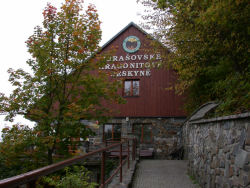
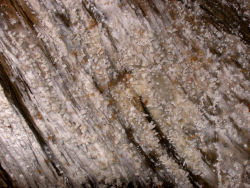
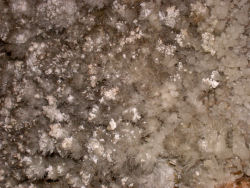
| Location: |
75351 Teplice nad Bečvou 75.
Near Teplice nad Bečvou. Leave 47 Olomuc-Ostrava at Hranice, 35 (E442) south. (49.5317177, 17.7457865) |
| Open: |
FEB to MAR Mon-Fri 10, 14. APR to JUN Tue-Sun 9-16. JUL to AUG Tue-Fri 9-16, Sat, Sun 9-17. SEP to OCT Tue-Sun 9-16. [2023] |
| Fee: |
Adults CZK 190, Children (3-15) CZK 100, Children (0-2) free, Students (-26) CZK 160, Disabled CZK 160, Seniors (65+) CZK 160. Photography Permit CZK 30, Video Permit CZK 100. [2023] |
| Classification: |
 Karst Cave Karst Cave
|
| Light: |
 Electric Light Electric Light
|
| Dimension: | L=1,240 m, VR=55 m, T=14-16 °C, H=90 %. |
| Guided tours: |
L=375 m, D=60 min, St=126. V=50,000/a [2000] V=60,000/a [2008] |
| Photography: | allowed, no flash, selfie stick or tripod |
| Accessibility: | no |
| Bibliography: | |
| Address: |
Správa Zbrašovských aragonitových jeskynĕ, Barbora Šimeèková, 75351 Teplice nad Bečvou 75, Tel: +420-581-601-866, Cell: +420-724-275-825.
E-mail: |
| As far as we know this information was accurate when it was published (see years in brackets), but may have changed since then. Please check rates and details directly with the companies in question if you need more recent info. |
|
History
| DEC-1912 | discovered by Josef Chromý and Čeněk Chromý. |
| 1914 | artificial entrance built, development as a show cave started. |
| 1925 | Spolek pro udržování zbrašovských jeskyní v Hranicích (The Association for Maintenance of the Zbrašov Caves in Hranice) founded. |
| 1926 | Čeněk Chromý commits suicide in one of the carbon dioxide lakes. |
| 1926 | opened to the public. |
| 1943 | death of Josef Chromý. |
| 1944 | Koblihová síň (Doughnut Hall) used as air raid shelter for mothers and children from the village of Zbrašov. |
| 1952 | Hůrka u Hranic National Nature Reserve declared. |
| 1952–1956 | cave modernized, new entrance building erected, new light system, new 40 m long entrance tunnel built. |
| 1981 | beginning of concerts, theatre performances, weddings and art exhibitions in the Mramorová síň (Marble Hall). |
| 1998 | heat pump installed in the entrance building. |
| 2003 | Zbrašovské aragonitové jeskyně (Zbrašov Aragonite Caves) declared a National Natural Monument. |
| 2002–2005 | extensive reconstruction of the tour path and its technical equipment. |
Description
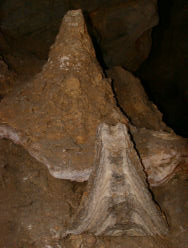
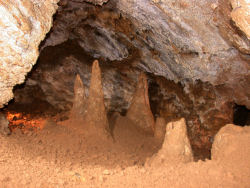
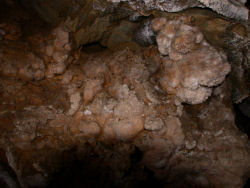
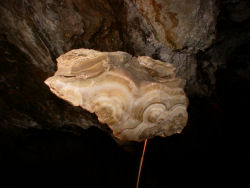
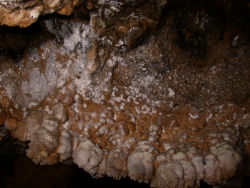
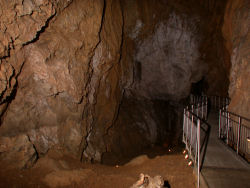
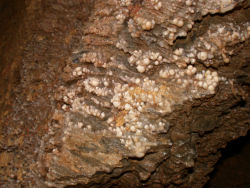
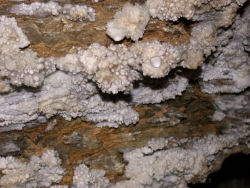
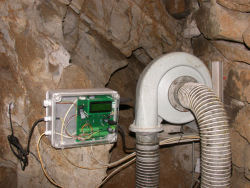
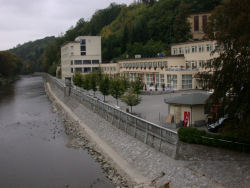
The Zbrašovské aragonitové jeskyně (Aragonite Caves of Zbrasov) are famous for aragonite speleothems, as the name already says. The geological situation in this cave was unique: despite karst solution mechanisms, thermal activity from below influenced the cave development. In the cave meteoric water from the surface and hot mineral water merged. The cave is much warmer than ordinary caves, with 14 °C it is the warmest cave of the country.
There is no village named Zbrasov, there is no village at all, but because of the thermal spring there is a spa named Teplice nad Bečvou. It is located south of Hranice, on the western side of river Recva and reached on road 35 towards Valašské Meziříčí from Hranice, which runs south on the other side of the river. At Hranice an access road branches of and crosses the river. Unfortunately, there is very limited parking space at the spa, so we recommend the parking lot at Teplice train station. Following road 35 we soon reach the train station, the parking lot is supervised. The cave is right on the other side of river Recva, to reach it you have to walk a few hundred meters north to the bridge.
The entrance to Zbrasov cave is located uphill, in a newly renovated entrance building with ticket office, a small shop and toilet. The exit is at the foot of the hill, so if you do not need to return uphill, do not leave anything at the entrance.
The first cave which was known in this part of the country was the Weißkirchener Abgrund (Hranice Abyss) which is located on the hill above the train station. This cave was found during quarry works in December 1912, when workers in the local Na Baránce quarry uncovered a fissure from which a thick column of steam was issuing when it was freezing outside. The brothers Josef and Čeněk Chromý where informed, because they were known to be interested in caves. They widened the fissure and gradually cleared up the cave debris, and in January 1913 they descended a 42 m deep shaft and entered Jurikův dóm (Jurik’s Dome). According to local lore, their rope was rather old and snapped during their first descent, so they fell on the slope at the bottom and broke their carbide lamps. They had to wait for 8 hours in complete darkness until they were rescued.
After the exploration of the cave, the cave survey showed the best spot for an artificial entrance to avoid the shaft. The early explorers were convinced to make the cave accessible to the public as soon as possible. They worked in the evenings after they had finished working at their regular jobs and dug an entrance tunnel, which was started in 1914. These enthusiasts called themselves Sbor dobrovolných zbrašovských havířů (The Volunteer Miners of Zbrašov). It seems the tunnel was completed the same year and then the construction of trails inside the cave started. Then World War I began, and many of them had to join the army. The few remaining members were not able to complete the work, and finally they completed it in 1925. At the end of 1925, the cave explorers and other institutions officially founded Spolek pro udržování zbrašovských jeskyní v Hranicích (The Association for Maintenance of the Zbrašov Caves in Hranice). The cave was opened as a show cave in 1926.
At the end of World War II, Koblihová síň (Doughnut Hall) was used as air raid shelter for mothers and children from the village of Zbrašov. The cave was modernized in the years 1952–1956. The new entrance building was erected, and the guided tour was equipped with a new light system. A new 40-m-long tunnel was dug from the spa colonnade to the cave. The second entrance allowed one way tours.
The cave is entered down a staircase in the first artificial tunnel to a depth of 16 m. The passage is horizontal and leads to the Zasedací síni (Assembly Hall), followed by the Koblihová síň (Doughnut Hall) with a memorial for the discoverer Josef Chromý. It was named after spherical formations on the walls which actually resemble doughnuts. The next chamber, the Gallašova dómu (Gallaš Dome) was named after the physician, philanthropist and writer Josef Heřman Agapit Gallaš (*1756–✝1840), a famous native of Hranice. Through a passage the Jurikova dómu (Jurik’s Dome) is reached, which is the largest chamber of the cave. It is also the place where in 1913 the first explorers descended from the surface through a 42-m deep shaft into the cave. At the far end, the floor slopes down to the lowest part, called the Tunnel, which is flooded with carbon dioxide and cannot be visited without oxygene. The guide demonstrates the CO2 lake with a simple experiment, an oil lamp which goes out as soon as it reaches the CO2 accumulation. The ceiling shows aragonite needles. The following passage is the jeskyně U Krokodýla (Crocodile Cave) which has further Geyser stalagmites and the Turecký hřbitov (Turkish Cemetery) with more minerals. An 80-m long tunnel, which was dug during the 2002-2005 renovation of the show cave, also led to the discovery of small caves which are now connected by the tunnel. A staircase descends into the Veselé jeskyně (Vesely Cave) and finally Mramorová síň (Marble Hall) is reached, which is used for exhibitions and concerts during summer. This is the lowest part of the cave and when the Bečva River raises, it may flood this part of the cave. A sign marks the level of the water during the disastrous floods in 1997. The cave is left through another artificial tunnel which ends on the embankment of the Bečva River next to the Kropáč acid spring.
The carbon dioxide (CO2) in the cave, which was a result of the thermal water, was always rather dangerous. It accumulated in deeper part forming lakes of carbon dioxide. While the gas is not poisonous, there is no oxygene and if one enters such a lake, one will suffocate without actually being aware of it. This makes the gas quite dangerous. In 1998, the heating system of the entrance building was modernized. It now uses a heat pump which uses the heat of the water from the lake in the inaccessible area called Béčko (“B”). In 2000 sensors were installed, and when they detect dangerous amounts of carbon dioxide, a ventilation system is started which removes the carbon dioxide. In 2005 the cave was again completely modernized. Also, a drainage system was installed, which pumps the water from the footpaths out of the caves to protect the spa mineral water running below from possible contamination.
The cave is quite special because of the thermal water, and the occurance of aragonite is just one difference. This is a result of its location at the border of two geological units, the Bohemian Massif and the Western Carpathians. Here is a thick formation of limestones from the Middle to Late Devonian (350–380 million years). During the Alpine-Carpathian orogeny, the nearby Carpathian Mountains were created. But this area was close enough to be lso affected, sediments of Cretaceous and Paleogene Carpathian flysch covered the limestone. It became exposed again by tectonic movements and erosion, and so the limestone was karstified. Due to the warmer climate, a conical karst with cone structures called mogotes formed. Today such karst areas form under tropical conditions in Asia and the Caribbean.
During the Tertiary the area was again flooded by the sea and covered by sediments, with only the tops of the former mogotes sticking out. As a result, only those exposed outcrops of limestones underwent intensive karstification. Sediments with fossils of molluscs survived from the Tertiary marine flooding were found in the Zbrašov Aragonite Caves, which proves that the caves already existed at that time. This is also the time when the hydrothermal springs formed. As a result of tectonic movements on deep faults between the Bohemian Massif and the Carpathian system cracks opened which allowed the groundwater to flow up and down. The springs at the cave have a temperatures of up to 22.5 °C, the water originates from a depth of about 700 m. It has a very high content of carbon dioxide and is very agressive, dissolving the limestone easily. The scientific term for the Hranice Karst is a conical hydrothermal cryptokarst.
Aragonite is rare in most caves, although it has the same chemical formula as limestone or calcite. But it has a different crystal structure which is called the rhombic system and generally forms needle-like crystals. Its formation requires higher temperatures and probably a different chemistry. Another rare modification of calcite is Vaterite which crystallizes in a hexagonal system.
But the unique feature of the cave are the Geyser stalagmites, which have a characteristic conical shape which is somewhat different from normal stalagmites. They also have a hole in the top of the stalagmite and a canal through the whole stalagmite, similar to a volcano. They actually look more like stratovolcanoes in small, and a longitudinal cross-section shows that they actually grow in layers. Also, their porous structure is quite distinct. They are also sometimes called "mud volcanoes". There are basically two theories of their origin. The first supposes that they were formed by crystallization of calcium carbonate around mineral water springs. The second one explains them as so-called raft cones, which developed on the bottom of cave lakes as accumulations of thin sinter crusts. They were primarily formed by evaporation of carbon dioxide from the water on the lake surface, and they were floating. Such rafts are well known and are responsible for the formation of many strange speleothems. Of course, biogenic processes may also play a role, a very recent theory that has been little researched scientifically. Unfortunately, nobody has ever found such a Geyser stalagmite in any cave of the world which is still active, in the process of formation, so all those theories remain theories.
Due to the high temperature, the biology of the caves is also quite unique. It was intensively researched between 2001 and 2004. Typical inhabitants are beetles (Coleoptera), diptera (Diptera) and butterflies (Lepidoptera), also springtails (Collembola), terrestrial isopods (Oniscidea), galleyworms (Diplopoda), centipedes (Chilopoda), spiders (Aranea) and pseudoscorpions (Pseudoscorpiones). The species Androniscus dentiger is rather frequent, a terrestrial isopod with an up to 6 mm long white body. It likes warmer caves and is thus known predominantly from Southern Europe.

|
| Zbrašovské aragonitové jeskyně Gallery |
- See also
 Member of the International Show Caves Association (ISCA)
Member of the International Show Caves Association (ISCA) Search DuckDuckGo for "Zbrasov Aragonite Cave"
Search DuckDuckGo for "Zbrasov Aragonite Cave" Google Earth Placemark
Google Earth Placemark Zbrašov Aragonite Caves - Wikipedia (visited: 30-AUG-2023)
Zbrašov Aragonite Caves - Wikipedia (visited: 30-AUG-2023) Zbrašov (Zbrašovské) Aragonite Caves, official website (visited: 29-AUG-2023)
Zbrašov (Zbrašovské) Aragonite Caves, official website (visited: 29-AUG-2023) The Zbrašovské Aragonite Caves (visited: 30-AUG-2023)
The Zbrašovské Aragonite Caves (visited: 30-AUG-2023) The Zbrašov Aragonite Caves – the warmest caves in the czech republic (visited: 30-AUG-2023)
The Zbrašov Aragonite Caves – the warmest caves in the czech republic (visited: 30-AUG-2023)
 Index
Index Topics
Topics Hierarchical
Hierarchical Countries
Countries Maps
Maps